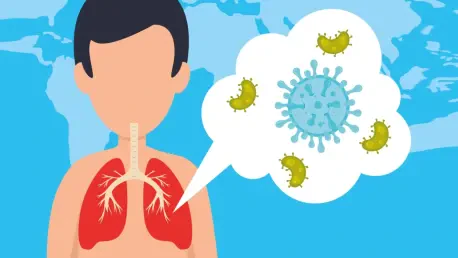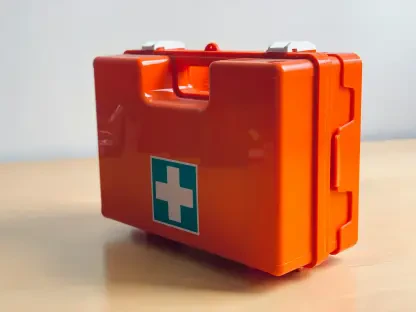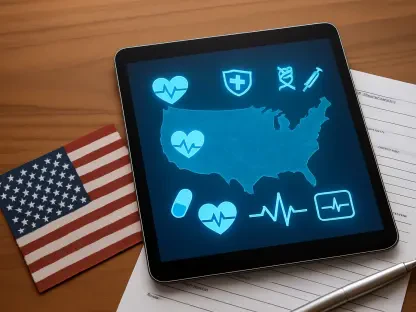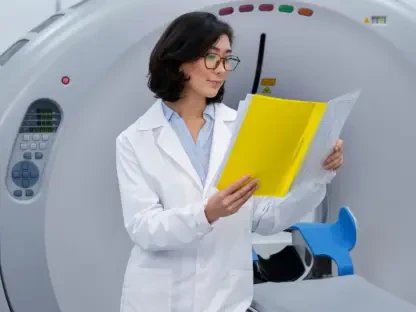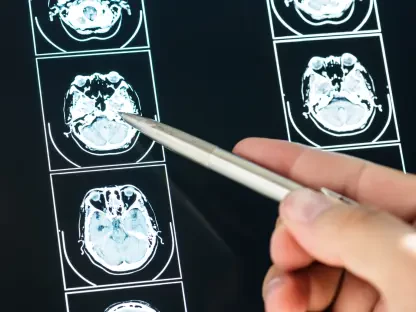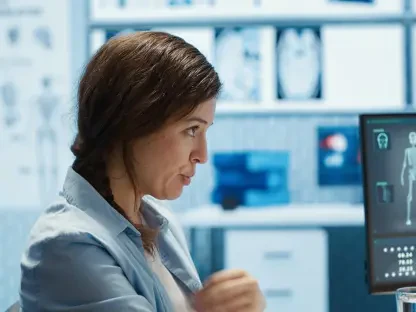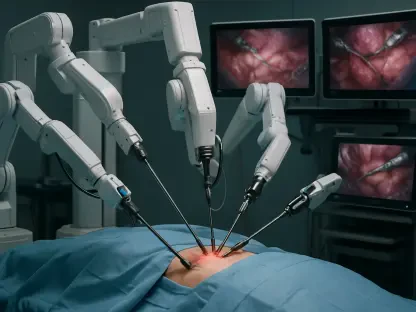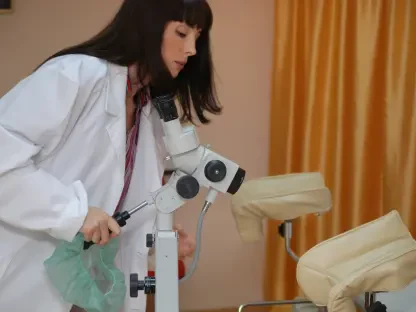In the vast landscape of U.S. health care, respiratory infections stand as a towering challenge, draining resources and impacting millions of lives each year with their relentless prevalence. These conditions, encompassing acute oropharyngeal infections and broader respiratory tract infections (RTIs), burden the system with an age-standardized incidence of roughly 339,703 cases per 100,000 individuals. Accounting for nearly one-fifth of outpatient visits, they contribute to over $1 billion in annual health care expenditures. The sheer scale of this issue underscores a pressing need for diagnostic tools that can swiftly and accurately identify pathogens to curb unnecessary treatments and escalating costs. Amidst this backdrop, syndromic real-time reverse transcriptase–polymerase chain reaction (RT-PCR) testing emerges as a potential game-changer, promising not only clinical precision but also economic relief. A recent study published in the American Journal of Managed Care dives into this possibility, comparing RT-PCR against traditional methods and no testing at all, offering fresh insights into managing a pervasive public health concern.
The Burden of Respiratory Infections
Understanding the Scale and Impact
The magnitude of respiratory infections in the U.S. cannot be overstated, as they represent a significant drain on both health care resources and patient well-being, with an incidence rate that translates to hundreds of thousands of cases per 100,000 people. Conditions like RTIs and oropharyngeal infections are a leading cause of medical consultations. Nearly 20% of outpatient visits are attributed to these ailments, reflecting their pervasive impact on everyday health care delivery. Beyond the frequency of encounters, the economic toll is staggering, with costs surpassing $1 billion annually. This financial burden stems from direct medical expenses, such as diagnostic tests and treatments, as well as indirect costs like lost productivity. The urgency to address this issue is further amplified by the fact that RTIs alone were linked to about 2% of all deaths in past data, highlighting their severity. Effective management of these infections is not just a matter of cost but also of life and death, pushing the need for innovative solutions to the forefront of health care priorities.
Delving deeper into the impact, the ripple effects of respiratory infections extend beyond immediate medical costs to broader systemic challenges, highlighting the urgent need for improved healthcare strategies. Each outpatient visit often triggers a cascade of follow-up appointments, prescriptions, and sometimes emergency interventions, especially when initial diagnoses are inaccurate or delayed. This cycle not only strains healthcare facilities but also places a heavy burden on patients, who face prolonged illness and financial stress. The high prevalence of these conditions means that even small inefficiencies in diagnosis or treatment can balloon into massive expenditures over time. Moreover, the public health implications are profound, as unchecked infections can spread rapidly, exacerbating community health risks. Addressing this burden requires a dual focus on improving clinical outcomes and reducing economic waste, setting the stage for advanced diagnostic tools to play a pivotal role in transforming how respiratory infections are managed across the nation.
Challenges with Current Diagnostic Approaches
Traditional diagnostic methods for respiratory infections often fall short of meeting the demands of timely and accurate identification, leading to significant downstream consequences that impact patient outcomes. Culture-based tests, long considered a standard for certain infections like streptococcal pharyngitis, suffer from slow turnaround times, often taking days to yield results. This delay can hinder prompt treatment, allowing symptoms to worsen and increasing the likelihood of complications. Additionally, these tests require specialized expertise, which may not be uniformly available across all healthcare settings. Rapid antigen point-of-care (POC) tests, while faster, frequently lack the sensitivity and specificity needed to detect a wide range of pathogens, especially in cases of mixed or complex infections. Such limitations often result in misdiagnosis, leaving clinicians to guess at appropriate therapies and patients to endure prolonged uncertainty.
The shortcomings of these conventional approaches have far-reaching implications for both patient care and healthcare costs, emphasizing the urgent need for improvement in diagnostic methods. Inaccurate or delayed diagnoses often lead to inappropriate antibiotic prescribing, a major contributor to antimicrobial resistance—a growing public health threat. When initial tests fail to pinpoint the causative pathogen, patients may require multiple follow-up visits or additional testing, driving up healthcare resource utilization (HCRU). Emergency department (ED) visits and prolonged outpatient care become more common as untreated or mistreated infections escalate. Economically, this inefficiency translates into higher expenditures for both providers and patients, as the system absorbs the cost of redundant services. The persistent gaps in current diagnostic capabilities underscore a critical need for more reliable and rapid tools to address the complexities of respiratory infections effectively.
Advantages of RT-PCR Testing
Diagnostic Superiority and Speed
Syndromic real-time reverse transcriptase–polymerase chain reaction (RT-PCR) testing stands out as a transformative advancement in the realm of respiratory infection diagnostics, offering unparalleled accuracy and efficiency. Unlike traditional methods, RT-PCR boasts high sensitivity and specificity, enabling it to detect a broad spectrum of pathogens—both viral and bacterial—in a single test. This capability is particularly crucial for conditions with overlapping symptoms, where distinguishing between causative agents can be challenging. The technology’s ability to deliver results within a day marks a significant leap forward, allowing clinicians to make informed decisions swiftly. Such speed contrasts sharply with the multi-day wait times of culture-based tests, positioning RT-PCR as a vital tool in settings where time is of the essence. By identifying the exact pathogen early, this method paves the way for precise interventions, potentially altering the course of patient recovery.
The rapid turnaround of RT-PCR testing not only enhances diagnostic precision but also reshapes the clinical decision-making process in meaningful ways. With next-day results, healthcare providers can initiate targeted treatments sooner, avoiding the guesswork that often accompanies slower or less accurate tests. This efficiency is especially beneficial in outpatient environments, where patients often present with non-specific symptoms that could indicate a range of infections. The comprehensive nature of RT-PCR, capable of screening for multiple pathogens simultaneously, reduces the need for sequential testing, streamlining the diagnostic pathway. Furthermore, this technology minimizes the risk of overlooking co-infections, which are common in respiratory cases but frequently missed by narrower tests. As a result, RT-PCR holds the potential to elevate the standard of care by ensuring that diagnoses are both accurate and actionable from the outset.
Impact on Patient Care
The adoption of RT-PCR testing can significantly enhance patient outcomes by addressing the pitfalls of delayed or incorrect diagnoses that plague traditional methods, leading to better health management. When pathogens are identified accurately and promptly, treatments can be tailored to the specific infection, reducing the likelihood of broad-spectrum antibiotic use that contributes to resistance. Patients benefit from shorter symptom duration and lower risks of complications, as therapies are initiated before conditions worsen. The precision of RT-PCR also means fewer instances of unnecessary prescriptions, which not only curbs costs for individuals but also alleviates the burden on healthcare systems grappling with overprescribing issues. This targeted approach fosters a higher quality of care, ensuring that patients receive the right intervention at the right time, ultimately improving their overall health trajectory.
Beyond immediate treatment benefits, RT-PCR testing contributes to a reduction in follow-up care needs, further enhancing the patient experience. With a more definitive initial diagnosis, the frequency of return visits for unresolved symptoms or incorrect treatments drops significantly. This reduction in repetitive medical encounters spares patients from prolonged discomfort and additional expenses while freeing up healthcare resources for others in need. The ripple effect of such efficiency can be seen in reduced congestion at outpatient clinics and emergency departments, where many respiratory infection cases often escalate due to initial mismanagement. By minimizing these downstream interactions, RT-PCR not only improves individual outcomes but also supports broader healthcare system stability, making it a compelling option for widespread clinical integration.
Economic and Clinical Outcomes
Reductions in Health Care Resource Utilization (HCRU)
A pivotal study examining the impact of RT-PCR testing reveals striking reductions in healthcare resource utilization (HCRU) among patients with respiratory infections, highlighting significant benefits for medical systems. Conducted on a commercially insured population under 65, the research demonstrates that individuals tested with RT-PCR experienced fewer outpatient visits, emergency department (ED) trips, and physician office consultations over a 6-month follow-up period compared to those assessed with other methods or not tested at all. Specifically, in the oropharyngeal infection cohort, only 86.8% of RT-PCR-tested patients had an outpatient visit post-diagnosis, compared to higher rates in matched groups using culture-based tests. The mean number of visits was also lower, showcasing a clear trend of decreased reliance on medical services. These findings suggest that the accuracy of RT-PCR curtails the need for repeated care, addressing a key driver of resource strain in healthcare settings.
The implications of reduced HCRU extend across various metrics, painting a comprehensive picture of RT-PCR’s impact on respiratory infection management, and for the RTI cohort, similar patterns emerged with a lower proportion of RT-PCR-tested patients requiring outpatient services (83.7%) and fewer mean visits compared to other diagnostic subcohorts. ED visits, often a costly and overburdened segment of care, saw significant declines, with RT-PCR patients recording fewer trips and lower per-patient averages. Physician office interactions followed suit, indicating that early, precise diagnoses prevent the escalation of cases that typically require multiple touchpoints. This consistent reduction across service categories underscores the potential of RT-PCR to streamline patient pathways, freeing up capacity in an often-overstretched healthcare infrastructure while maintaining or even enhancing care quality.
Cost Savings Potential
One of the most compelling aspects of RT-PCR testing lies in its ability to drive substantial cost savings for both patients and the broader healthcare system. The aforementioned study provides concrete evidence of lower average total healthcare costs for individuals tested with RT-PCR compared to those diagnosed with culture-based methods. In the oropharyngeal infection cohort, total outpatient service costs averaged $2,598 for RT-PCR versus $2,970 for culture, while in the RTI group, the figures were $2,796 against $3,221. These differences, though seemingly modest per patient, accumulate into significant savings when scaled across thousands of cases. The reductions span various expense categories, including physician visits, ED costs, and other medical services, highlighting how upfront diagnostic accuracy can prevent costly downstream interventions.
Further analysis of the economic benefits reveals that RT-PCR’s cost-effectiveness stems from its prevention of unnecessary follow-up care and redundant testing. By delivering a definitive diagnosis early, the technology minimizes the recurring expenses tied to inconclusive or delayed results from traditional methods. Total healthcare costs, encompassing both medical and pharmacy expenditures, were notably lower at $4,892 for RT-PCR compared to $5,568 for culture in oropharyngeal cases, with a similar gap in RTI cases ($6,321 versus $7,404). These savings are not merely numerical but translate into tangible relief for payers and patients alike, reducing financial stress in a system often criticized for escalating costs. As healthcare expenditures continue to rise, embracing diagnostic tools like RT-PCR could offer a sustainable path to balancing clinical excellence with fiscal responsibility.
Barriers and Future Directions
Hurdles to Adoption
Despite the clear advantages of RT-PCR testing, its adoption in U.S. clinical practice remains surprisingly low, posing a significant barrier to realizing its full potential. Several factors may contribute to this underutilization, including the perceived upfront costs of implementing advanced molecular diagnostics in diverse healthcare settings. While the long-term savings are evident, the initial investment in equipment, training, and infrastructure can deter smaller practices or resource-constrained facilities from making the switch. Additionally, a lack of awareness or familiarity among healthcare providers about the benefits and operational integration of RT-PCR may further hinder its uptake. Without targeted education and outreach, many clinicians may default to familiar, though less effective, traditional methods, perpetuating inefficiencies in respiratory infection management.
Logistical challenges also play a critical role in slowing the widespread implementation of RT-PCR testing across the healthcare landscape. The need for specialized laboratories or partnerships to process tests with next-day results can be a stumbling block, particularly in rural or underserved areas where access to such resources is limited. Furthermore, integrating this technology into existing workflows requires coordination and policy support, which may lag behind technological advancements. Resistance to change within established medical protocols can compound these issues, as can uncertainties around reimbursement models that fail to incentivize the adoption of costlier initial diagnostics despite their downstream benefits. Overcoming these hurdles demands a multifaceted approach, involving collaboration between diagnostic developers, providers, and insurers to align on strategies that prioritize long-term value over short-term expenditure.
Expanding Research and Applicability
While the current study on RT-PCR testing offers robust insights, its focus on a commercially insured population under 65 raises questions about the broader applicability of its findings. Older adults, who often face higher risks from respiratory infections, and those covered by public insurance programs like Medicare or Medicaid, may experience different healthcare dynamics that could influence outcomes. Factors such as comorbidity prevalence, access to care, and reimbursement structures vary significantly across demographic and payer groups, potentially affecting both healthcare resource utilization (HCRU) and cost outcomes. Expanding research to include these populations is essential to determine whether RT-PCR’s benefits hold universally or require tailored approaches to maximize impact in diverse contexts.
Beyond population scope, several unaddressed variables warrant further investigation to refine the understanding of RT-PCR’s role in respiratory infection care. The influence of symptom severity on test selection and subsequent resource use remains unclear, as does the precise impact of rapid result delivery on provider decision-making. Prospective studies could control for these elements, offering deeper insights into how and when RT-PCR delivers the greatest value. Additionally, exploring the timing of post-diagnosis utilization—whether short-term repeat visits or long-term care differences—could clarify the technology’s full economic footprint. Stratifying data by specific diagnoses and geographic settings would further enhance comparability, ensuring that future policies and clinical guidelines are grounded in comprehensive, real-world evidence.
Implications for Health Care Systems
Policy and Practice Shifts
The evidence supporting RT-PCR testing presents a compelling case for healthcare policymakers and payers to reconsider current approaches to diagnostic reimbursement and adoption, ensuring that innovative methods are prioritized. Adjusting payment models to cover the initial costs of molecular testing could accelerate its integration into routine care, especially given the demonstrated downstream savings in outpatient and emergency services. Incentives for providers to adopt RT-PCR, such as value-based care frameworks that reward reduced healthcare resource utilization (HCRU), could further drive uptake. For clinicians, incorporating this technology into standard protocols for respiratory infections—particularly in high-volume outpatient settings—offers a pathway to enhance diagnostic accuracy and patient management. Such shifts in policy and practice could align financial structures with clinical goals, prioritizing long-term efficiency over short-term cost concerns.
Equally important is the role of education and training in facilitating a smooth transition to RT-PCR-based diagnostics within health care systems. Providers must be equipped with the knowledge and tools to interpret and act on rapid, comprehensive test results effectively. This requires targeted programs to bridge gaps in understanding and address any hesitancy toward adopting new technologies. Collaboration between diagnostic companies and health care organizations can support these efforts, ensuring that implementation is both practical and sustainable. Additionally, policymakers should consider equity in access, advocating for solutions that bring RT-PCR testing to underserved regions where respiratory infections often pose disproportionate risks. By embedding this technology into the fabric of care delivery, health care systems can move toward a future where precision and cost-effectiveness go hand in hand.
Scaling Impact
Looking back, the journey of integrating RT-PCR testing into respiratory infection management revealed a powerful potential to transform healthcare delivery, as evidenced by past reductions in both resource use and costs. The consistent findings of fewer outpatient visits and lower expenditures compared to traditional methods underscored a shift that had already begun to take shape. Reflecting on those outcomes, it became clear that scaling this impact demanded addressing real-world implementation challenges with deliberate strategies. Healthcare systems needed to prioritize partnerships that ensured test availability across varied settings, from urban hospitals to rural clinics, to maximize reach and benefit.
Recalling the barriers identified in earlier discussions, the path forward involved a commitment to innovative solutions that tackled logistical and educational hurdles head-on, ensuring a robust strategy for improvement. Investments in mobile diagnostic units or telehealth integrations could have bridged access gaps, while continuous provider training programs ensured sustained adoption. The momentum built from initial studies suggested that with coordinated efforts, RT-PCR had the capacity to redefine outpatient care standards over time. Moving ahead, stakeholders were encouraged to focus on pilot programs that tested scalability models, alongside advocacy for policy reforms that supported equitable deployment. These steps promised to cement RT-PCR’s role as a cornerstone in managing respiratory infections, balancing clinical excellence with economic prudence for years to come.
